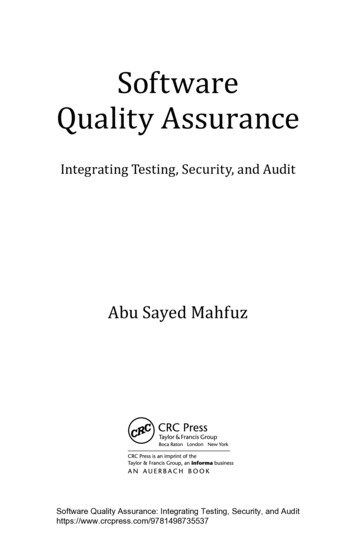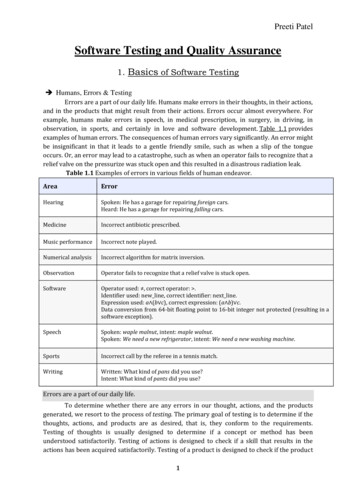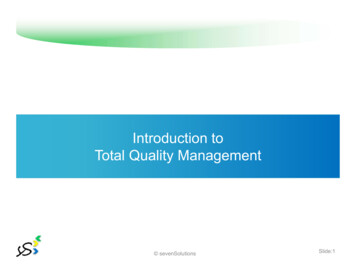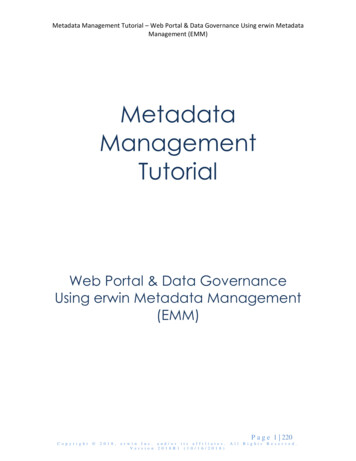
Transcription
About the TutorialSoftware Quality Management is a process that ensures the required level of softwarequality is achieved when it reaches the users, so that they are satisfied by its performance.The process involves quality assurance, quality planning, and quality control.This tutorial provides a complete overview of Software Quality Management and describesthe various steps involved in the process. The entire content is divided into sections foreasy understanding.AudienceThis tutorial is designed for software development professionals so that they canunderstand the importance of software quality management. It is especially beneficial forsoftware quality managers, software testing professionals, and software developers.PrerequisitesTo get the most out of this tutorial, it is good to have a basic understanding of the SoftwareDevelopment Life Cycle (SDLC).Copyright & Disclaimer Copyright 2018 by Tutorials Point (I) Pvt. Ltd.All the content and graphics published in this e-book are the property of Tutorials Point (I)Pvt. Ltd. The user of this e-book is prohibited to reuse, retain, copy, distribute or republishany contents or a part of contents of this e-book in any manner without written consentof the publisher.We strive to update the contents of our website and tutorials as timely and as precisely aspossible, however, the contents may contain inaccuracies or errors. Tutorials Point (I) Pvt.Ltd. provides no guarantee regarding the accuracy, timeliness or completeness of ourwebsite or its contents including this tutorial. If you discover any errors on our website orin this tutorial, please notify us at contact@tutorialspoint.comi
Table of ContentsAbout the Tutorial . iAudience . iPrerequisites . iCopyright & Disclaimer. iTable of Contents . ii1.SQM INTRODUCTION. 1The Software Quality Challenge . 12.SQM SOFTWARE QUALITY FACTORS . 3McCall’s Factor Model . 3Product Operation Software Quality Factors . 3Product Revision Quality Factors . 4Product Transition Software Quality Factor . 53.SQM SQA COMPONENTS . 6Components of SQA System . 7Pre-project Software Quality Components . 84.SQM SOFTWARE QUALITY METRICS . 9Product Quality Metrics . 9In-process Quality Metrics . 10Maintenance Quality Metrics . 125.SQM BASICS OF MEASUREMENT . 14Measurement in Everyday Life . 14Measurement in Software Engineering . 14The Representational Theory of Measurement . 156.SQM MEASUREMENT & MODELS . 18ii
7.SQM MEASUREMENT SCALES . 20Nominal Scale . 20Ordinal Scale . 20Interval Scale . 20Ratio Scale . 21Absolute Scale . 218.SQM EMPIRICAL INVESTIGATIONS . 22Choosing an Investigation Technique . 22Stating the Hypothesis . 23Maintaining Control over Variables . 23Making the Investigation Meaningful . 239.SQM SOFTWARE MEASUREMENT. 25Classifying the Entities to be Examined . 25Determining Relevant Measurement Goals . 26Identifying the Level of Maturity . 2810. SQM SOFTWARE MEASUREMENT VALIDATION . 30Validating the Measurement Systems . 30Validating the Prediction Systems . 3011. SQM SOFTWARE METRICS . 32Scope of Software Metrics . 3212. SQM DATA MANIPULATION. 35What is Good Data? . 35How to Define the Data? . 35How to Collect Data? . 36How to Store and Extract Data . 36iii
13. SQM ANALYZING SOFTWARE MEASUREMENT DATA . 38The Nature of Data . 38The Purpose of the Experiment . 38Design Considerations . 4014. SQM INTERNAL PRODUCT ATTRIBUTES . 41Measuring Internal Product Attributes . 4115. SQM ALBRECHT’S FUNCTION POINT METHOD . 44What is a Function Point?. 44Applying Albrecht’s Function Point Method . 4416. SQM MEASURING THE STRUCTURE . 48Types of Structural Measures . 48Measuring Control-Flow Structure . 48Measuring Data-Flow Structure . 48Measuring Data Structure . 4917. SQM STANDARDS AND CERTIFICATES . 50SQA Standards . 50ISO 9001 Certification. 5118. SQM SOFTWARE PROCESS ASSESSMENT . 54Software Process Maturity Assessment . 54Software Process Assessment Cycle . 55SCAMPI . 5519. SQM QUALITY ASSURANCE . 57Objectives of SQA Activities . 57Organizing for Quality Assurance . 57iv
20. SQM ROLE OF MANAGEMENT IN QA . 59Top Management Responsibilities in Software Quality . 59Software Quality Policy . 5921. SQM THE SQA UNIT . 64Tasks Performed by the Head of the SQA Unit . 64Project Life Cycle SQA . 65SQA Infrastructure Operations Tasks . 66SQA Internal Audit and Certification Tasks . 66SQA Support Tasks . 68SQA Standards and Procedures Tasks . 68SQA Engineering Tasks . 68SQA Information Systems Tasks . 69SQA Trustees and Their Tasks . 69SQA Committees and Their Tasks . 70v
1. SQM IntroductionQuality software refers to a software which is reasonably bug or defect free, is deliveredin time and within the specified budget, meets the requirements and/or expectations, andis maintainable. In the software engineering context, software quality reflects bothfunctional quality as well as structural quality. Software Functional Quality It reflects how well it satisfies a given design,based on the functional requirements or specifications. Software Structural Quality It deals with the handling of non-functionalrequirements that support the delivery of the functional requirements, such asrobustness or maintainability, and the degree to which the software was producedcorrectly. Software Quality Assurance Software Quality Assurance (SQA) is a set ofactivities to ensure the quality in software engineering processes that ultimatelyresult in quality software products. The activities establish and evaluate theprocesses that produce products. It involves process-focused action. Software Quality Control Software Quality Control (SQC) is a set of activitiesto ensure the quality in software products. These activities focus on determiningthe defects in the actual products produced. It involves product-focused acction.The Software Quality ChallengeIn the software industry, the developers will never declare that the software is free ofdefects, unlike other industrial product manufacturers usually do. This difference is due tothe following reasons.Product ComplexityIt is the number of operational modes the product permits. Normally, an industrial productallows only less than a few thousand modes of operation with different combinations of itsmachine settings. However, software packages allow millions of operational possibilities.Hence, assuring of all these operational possibilities correctly is a major challenge to thesoftware industry.Product VisibilitySince the industrial products are visible, most of its defects can be detected during themanufacturing process. Also the absence of a part in an industrial product can be easilydetected in the product. However, the defects in software products which are stored ondiskettes or CDs are invisible.Product Development and Production ProcessIn an industrial product, defects can be detected during the following phases: Product development: In this phase, the designers and Quality Assurance (QA)staff checks and tests the product prototype to detect its defects.1
Product production planning: During this phase, the production process andtools are designed and prepared. This phase also provides opportunities to inspectthe product to detect the defects that went unnoticed during the developmentphase. Manufacturing: In this phase, QA procedures are applied to detect failuresproducts themselves. Defects in the product detected in the first periodmanufacturing can usually be corrected by a change in the product’s designmaterials or in the production tools, in a way that eliminates such defectsproducts manufactured in future.ofoforinHowever, in the case of software, the only phase where defects can be detected is thedevelopment phase. In case of software, product production planning and manufacturingphases are not required as the manufacturing of software copies and the printing of softwaremanuals are conducted automatically.The factors affecting the detection of defects in software products versus other industrialproducts are shown in the following table.These characteristics of software such as complexity and invisibility make the developmentof software quality assurance methodology and its successful implementation a highlyprofessional challenge.2
2. SQM Software Quality FactorsThe various factors, which influence the software, are termed as software factors. Theycan be broadly divided into two categories. The first category of the factors is of those thatcan be measured directly such as the number of logical errors, and the second categoryclubs those factors which can be measured only indirectly. For example, maintainabilitybut each of the factors is to be measured to check for the content and the quality control.Several models of software quality factors and their categorization have been suggestedover the years. The classic model of software quality factors, suggested by McCall, consistsof 11 factors (McCall et al., 1977). Similarly, models consisting of 12 to 15 factors, weresuggested by Deutsch and Willis (1988) and by Evans and Marciniak (1987).All these models do not differ substantially from McCall’s model. The McCall factor modelprovides a practical, up-to-date method for classifying software requirements (Pressman,2000).McCall’s Factor ModelThis model classifies all software requirements into 11 software quality factors. The 11factors are grouped into three categories – product operation, product revision, andproduct transition factors. Product operation factors: Correctness, Reliability, Efficiency, Integrity, Usability. Product revision factors: Maintainability, Flexibility, Testability. Product transition factors: Portability, Reusability, Interoperability.Product Operation Software Quality FactorsAccording to McCall’s model, product operation category includes five software qualityfactors, which deal with the requirements that directly affect the daily operation of thesoftware. They are as follows:CorrectnessThese requirements deal with the correctness of the output of the software system. They include: Output mission The required accuracy of output that can be negatively affected by inaccurate dataor inaccurate calculations. The completeness of the output information, which can be affected by incomplete data. The up-to-dateness of the information defined as the time between the event andthe response by the software system. The availability of the information.3
The standards for coding and documenting the software system.ReliabilityReliability requirements deal with service failure. They determine the maximum allowedfailure rate of the software system, and can refer to the entire system or to one or moreof its separate functions.EfficiencyIt deals with the hardware resources needed to perform the different functions of thesoftware system. It includes processing capabilities (given in MHz), its storage capacity(given in MB or GB) and the data communication capability (given in MBPS or GBPS).It also deals with the time between recharging of the system’s portable units, such as,information system units located in portable computers, or meteorological units placedoutdoors.IntegrityThis factor deals with the software system security, that is, to prevent access tounauthorized persons, also to distinguish between the group of people to be given read aswell as write permit.UsabilityUsability requirements deal with the staff resources needed to train a new employee andto operate the software system.Product Revision Quality FactorsAccording to McCall’s model, three software quality factors are included in the productrevision category. These factors are as follows:MaintainabilityThis factor considers the efforts that will be needed by users and maintenance personnelto identify the reasons for software failures, to correct the failures, and to verify thesuccess of the corrections.FlexibilityThis factor deals with the capabilities and efforts required to support adaptive maintenanceactivities of the software. These include adapting the current software to additionalcircumstances and customers without changing the software. This factor’s requirementsalso support perfective maintenance activities, such as changes and additions to thesoftware in order to improve its service and to adapt it to changes in the firm’s technicalor commercial environment.TestabilityTestability requirements deal with the testing of the software system as well as with itsoperation. It includes predefined intermediate results, log files, and also the automaticdiagnostics performed by the software system prior to starting the system, to find outwhether all components of the system are in working order and to obtain a report about4
the detected faults. Another type of these requirements deals with automatic diagnosticchecks applied by the maintenance technicians to detect the causes of software failures.Product Transition Software Quality FactorAccording to McCall’s model, three software quality factors are included in the producttransition category that deals with the adaptation of software to other environments andits interaction with other software systems. These factors are as follows:PortabilityPortability requirements tend to the adaptation of a software system to otherenvironments consisting of different hardware, different operating systems, and so forth.The software should be possible to continue using the same basic software in diversesituations.ReusabilityThis factor deals with the use of software modules originally designed for one project in anew software project currently being developed. They may also enable future projects tomake use of a given module or a group of modules of the currently developed software.The reuse of software is expected to save development resources, shorten thedevelopment period, and provide higher quality modules.InteroperabilityInteroperability requirements focus on creating interfaces with other software systems orwith other equipment firmware. For example, the firmware of the production machineryand testing equipment interfaces with the production control software.5
3. SQM SQA ComponentsSoftware Quality Assurance (SQA) is a set of activities for ensuring quality in softwareengineering processes. It ensures that developed software meets and complies with thedefined or standardized quality specifications. SQA is an ongoing process within theSoftware Development Life Cycle (SDLC) that routinely checks the developed software toensure it meets the desired quality measures.SQA practices are implemented in most types of software development, regardless of theunderlying software development model being used. SQA incorporates and implementssoftware testing methodologies to test the software. Rather than checking for quality aftercompletion, SQA processes test for quality in each phase of development, until thesoftware is complete. With SQA, the software development process moves into the nextphase only once the current/previous phase complies with the required quality standards.SQA generally works on one or more industry standards that help in building softwarequality guidelines and implementation strategies.It includes the following activities: Process definition and implementation Auditing TrainingProcesses could be: Software Development Methodology Project Management Configuration Management Requirements Development/Management Estimation Software Design Testing, etc.Once the processes have been defined and implemented, Quality Assurance has thefollowing responsibilities: Identify the weaknesses in the processes Correct those weaknesses to continually improve the process6
Components of SQA SystemAn SQA system always combines a wide range of SQA components. These componentscan be classified into the following six classes:Pre-project componentsThis assures that the project commitments have been clearly defined considering theresources required, the schedule and budget; and the development and quality plans havebeen correctly determined.Components of project life cycle activities assessmentThe project life cycle is composed of two stages: the development life cycle stage and theoperation–maintenance stage.The development life cycle stage components detect design and programming errors. Itscomponents are divided into the following sub-classes: Reviews, Expert opinions, andSoftware testing.The SQA components used during the operation–maintenance phase include specializedmaintenance components as well as development life cycle components, which are appliedmainly for functionality to improve the maintenance tasks.Components of infrastructure error prevention and improvementThe main objective of these components, which is applied throughout the entireorganization, is to eliminate or at least reduce the rate of errors, based on theorganization’s accumulated SQA experience.Components of software quality managementThis class of components deal with several goals, such as the control of development andmaintenance activities, and the introduction of early managerial support actions thatmainly prevent or minimize schedule and budget failures and their outcomes.Components of standardization, certification, & SQA system assessmentThese components implement international professional and managerial standards withinthe organization. The main objectives of this class are utilization of internationalprofessional knowledge, improvement of coordination of the organizational qualitysystems with other organizations, and assessment of the achievements of quality systemsaccording to a common scale. The various standards may be classified into two maingroups: quality management standards and project process standards.Organizing for SQA – the human componentsThe SQA organizational base includes managers, testing personnel, the SQA unit and thepersons interested in software quality such as SQA trustees, SQA committee members,and SQA forum members. Their main objectives are to initiate and support theimplementation of SQA components, detect deviations from SQA procedures andmethodology, and suggest improvements.7
End of ebook previewIf you liked what you saw Buy it from our store @ https://store.tutorialspoint.com8
Software Quality Assurance Software Quality Assurance (SQA) is a set of activities to ensure the quality in software engineering processes that ultimately result in quality software produc










